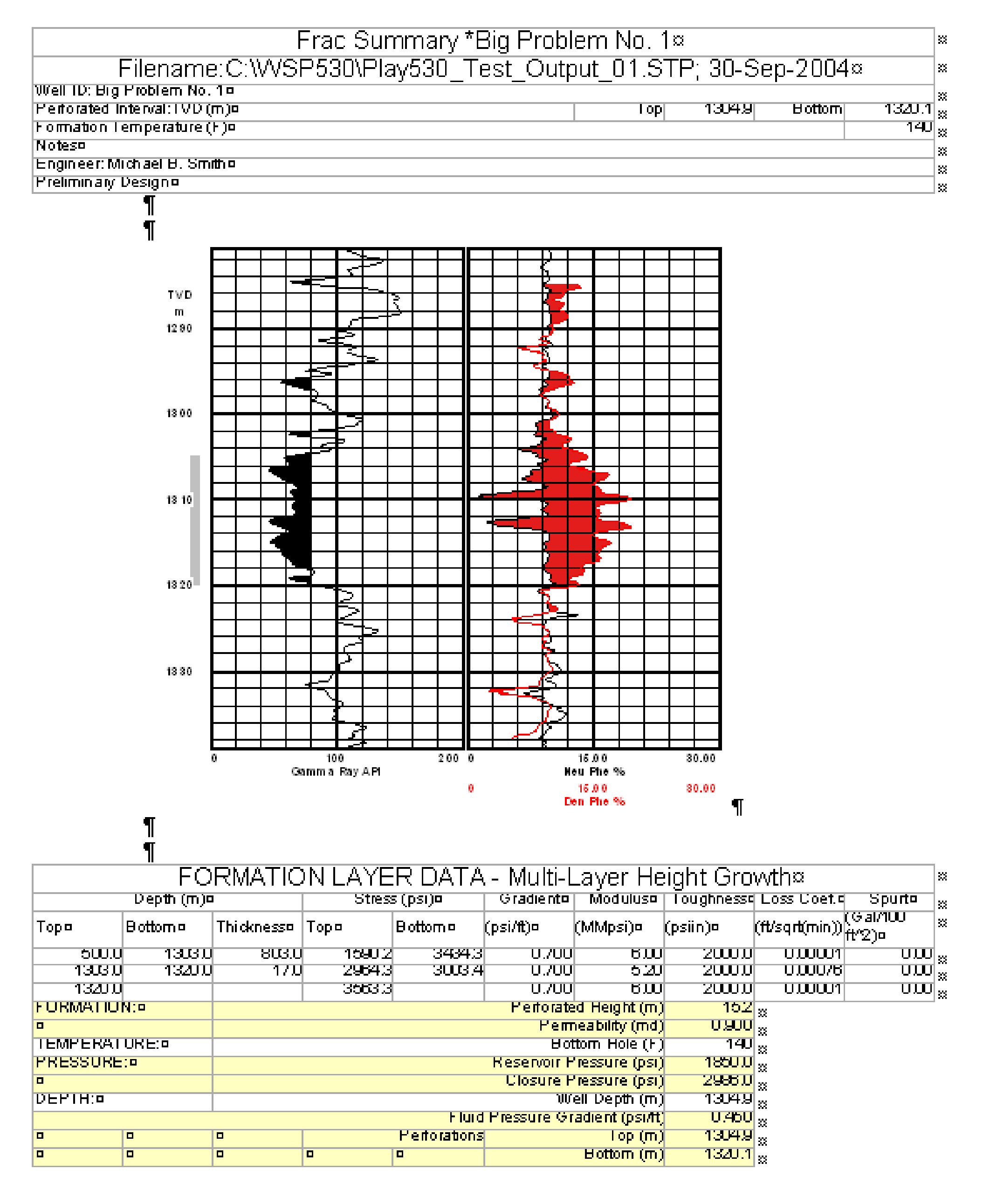Hydraulic Fracturing Engineering and Software Solution, for Your Most Challenging Reservoirs.
Changes – StimPlan/E-StimPlan 5.40 January 2006
StimPlan
- Added Graphical Input for fluid and proppant data.
- Allow direct use of detailed E-StimPlan simulation results for fracture width, conductivity, etc. in reservoir model simulations.

- Improved input for geomechanical inputs (input stress as a “gradient from surface” as well as the traditional input where stress is entered directly), include direct commands to “Shift Modulus”, set “Closure Stress”, etc.
- Expanded reservoir model to include “Frac-Pack” simulations including the near well affects of a gravel pack completion (including rigorous simulation of near well non-Darcy flow effects).
- Ability to overlay multiple log tracks in graphical output of geomechanical input data.
- Made all windows locations permanent. Thus, if the default window location is moved to avoid the Microsoft Office bar – this new location becomes permanent.
- Expanded Pump Schedule input to allow 100 stages.
- Added graphic output of pressure (surface and/or bottomhole) from reservoir model simulations. This was primarily for use in production history matching.
- Further expanded the “Report” format output with direct, formatted output to WORD and/or EXCEL.
E-StimPlan
- Frac-Pack Module – An industry first ! A rigorous wellbore, gravel pack simulation coupled to the 3D fracture simulation. This allows detailed examination of the effect of changing perforation patterns, taking returns, etc. on the final wellbore pack.
- Batch mode runs – The rigorous E-StimPlan Fully 3D simulations can be time consuming for some applications. This new feature allows creating a “task list” of runs. These are then executed over-night, with the results automatically archived at the completion of each simulation.
- Improved Scaling, made user input scaling “sticky”, and added “Zoom” to E-StimPlan Contour Plots.
Analysis Module
- Improved use of derivatives in Pressure Decline Analysis. This includes a refined calculation of the derivative smoothing allowing easier user input for this and a direct “Derivative Zoom” to expand the derivative scale to the range desired.
- Expanded the “ACA for permeability” analysis to include a Type Curve Analysis. This allows permeability determination with shorter shut-in times.
- Added log calculations for integrating density logs for OB.
- Expanded the log input to allow the input of multiple logs from a TXT file.
- Added tighter integration between “StimPlan” and the “Analysis” of step-Down Test data.
- Real-Time Acquisition – Allow more user control of the data acquisition time.
Changes – StimPlan/E-StimPlan 5.30/5.30A November 2004
StimPlan
- Significantly expanded/improved “Report” format output with direct, formatted output to WORD and/or EXCEL, i.e., “fancy” reports including automatic embedded graphics. An example “RTF” file (which is opened by WORD) is attached.
- Expanded the ability to define layer properties (modulus, fluid loss, etc.)by “Name” into a full “Database” format. This is also used, for example, to shift the stress in all “My Formation Shale” layers, making it possible to change modulus, stress, etc. in several formation layers in unison. This now allows the building of a “database” of formation properties and the rapid creation of a “geologic model” for a particular well.
- Multi-lingual versions for our multi-national users. Russian & Chinese versions available, with other versions to follow.
- Integration with Guydon Software SMARTS software for accessing hardware, real-time data acquisition and analysis, etc.
- Added the ability to customize legend information (location, fonts, etc.) for ALL StimPlan graphs (simulation output plots, Analysis plots, etc.).
- Added non-Darcy flow calculations for oil wells to the numerical reservoir model (non-Darcy calculations for gas wells has already been included for several years).
- Expanded Graphical Input capability to include display of multiple log tracks.
- Further expand “Create New Dataset” input “Wizard” to assist with starting from scratch to create a new dataset.

E-StimPlan
- THE Acid Fracturing Module – A limited version of the new E-StimPlan Acid Fracturing model being devel-oped through our association with Professors Dan Hill and Ding Zhu at Texas A&M University was released with Version 5.21. Version 5.30 represents the first release of the “real” E-StimPlan acid fracturing simulations with acid mixtures, complex fluid loss calculations including a rigorous (numerical) solution for stage dependent loss and wormholes, acid etched natural fracture fluid loss, advanced correlations for ionic acid diffusion and acid reaction rates, and other features. We think we can safely say that this represents the first serious attempt to rigorously simulate all aspects of the complex acid fracturing process.
- Add pressure dependent natural fracture fluid loss calculations. As with the acid simulations above, this includes a rigorous numerical solution for fluid loss.
- Add a numerical simulation for fluid loss capable of correctly simulating stage dependent fluid loss. Previously, this could only be done using the “Fully Coupled Model” as discussed below.
- Dramatically improve the FULLY COUPLED FRACTURE GEOMETRY MODEL WITH 3D RESERVOIR MODEL including poro-and thermal effects for thermal fracturing in terms of stability. This provides the most advanced simulation capabilities existing for water injection, waste-water disposal, drill cuttings injection, and for hydraulic fracturing in very high permeability environments (where many normal one-dimensional fluid loss assumptions used in fracture simulations are NOT appropriate).
Analysis Module (Version 5.30A only)
- Add dipole sonic log calculations for dynamic stress/modulus log values, including tools for shifting the log values to calibrated local conditions. Calibrated log values are then automatically used to define layer properties for use in rigorous StimPlan/E-StimPlan gridded simulations.
- Add a Log “Template” to Logs for saving and automatically restoring specific log display layouts (scales, pay identification, shadings, etc.)
- Expanded ACA (After Closure Analysis) for determining formation permeability from injection/decline (i.e., stress test/ mini-frac data) tests. One major addition is the inclusion of a “Volumes” plot for calculating injection volume.
